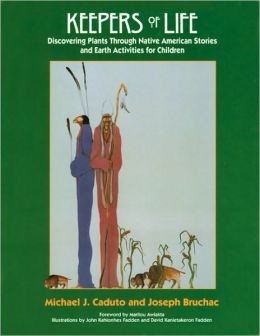| ________________
CM . . .
. Volume XIX Number 38. . . .May 31, 2013
The excerpt above shares the essence of this book, emphasizing the need to respect the natural heritage we have been gifted with and recognize that we are all Keepers of Life. This book is an excellent school resource for introducing children to Indigenous world views. It is comprised of 18 story packages which may be used as teaching tools in the classroom. The stories are divided by subject nature and include one introduction story, two stories about creation, one about celebration, thanksgiving and stewardship, eight about flowers and fruits, seeds and spores, five about survival, and one about healing our relations. Each traditional story acknowledges the Native North American cultures in which the story originated. An accompanying map helps readers situate where these different cultural groups traditionally resided. The stories are typically one to three pages long, making them ideal for sharing in the oral tradition. The stories are accompanied by beautiful black and white ink drawings, artistically representing the events and characters in each story. Following each story is a discussion prompt to help teachers explain the story’s context. The discussion prompts relate the story to Native North American traditional world views and emphasize mankind’s interconnection with the natural world. Following the discussion prompts, there is a list of questions to encourage student reflection. Some of the questions are focussed more on story comprehension while others encourage children to reflect on the greater meaning of the story and how it relates to their daily life. Once a story has been shared, and students have reflected on the story via class discussion, Keepers of Life offers suggestions for activities to solidify and expand the learning of the story. Activity suggestions include field trips, demonstrations, experimentation, and further discussion. Each story is accompanied by at least one activity with recommendations as to which age group to cater the activity to. While most of the activities seem catered to grades 3-8, there are many activities that could suit the needs of older or younger children with little or no modification. The activities section is often accompanied with black and white diagrams or photographs to help convey the activity details and execution. A "Glossary and Pronunciation Key to Native North American Words and Names" are at the end of the book. This combination proves most helpful for pronouncing new words and understanding new phrases. Joseph Bruchac also includes a section highlighting "Other Versions of Native American Stories" in which Bruchac discusses his story selection process and his interest in respecting the traditional oral culture of Native American stories. In this section, he also includes a thank-you to communities and individuals who aided in the story sharing process. "Keepers of the Earth" includes both an "Index of Activities by Subject'"and a "General Index" to improve search ability. In addition, this book includes a list of permissions, acknowledging resources that were collected and modified, including illustrations, photographs, maps, quotations, and activities. Keepers of Life is an excellent teacher resource that guides learning opportunities through the medium of storytelling and personal experience. The beginning of the book actually includes two chapters to help guide teachers in the use of this book. It is a versatile resource which could easily be incorporated into basic science lessons, social studies lessons, or language arts lessons. Readers may have seen this title previously published. The book is essentially the same, with slight modification of the cover. If you have not had a chance to acquire the earlier edition, I recommend picking up a copy of this reprint.
Recommended. Rachel Yaroshuk is a Masters of Library and Information Studies student at the University of British Columbia in Vancouver, BC.
To comment
on this title or this review, send mail to cm@umanitoba.ca.
Copyright © the Manitoba Library Association. Reproduction for personal
use is permitted only if this copyright notice is maintained. Any
other reproduction is prohibited without permission.
NEXT REVIEW |
TABLE OF CONTENTS FOR THIS ISSUE
- May 31, 2013.
AUTHORS |
TITLES |
MEDIA REVIEWS |
PROFILES |
BACK ISSUES |
SEARCH |
CMARCHIVE |
HOME |
